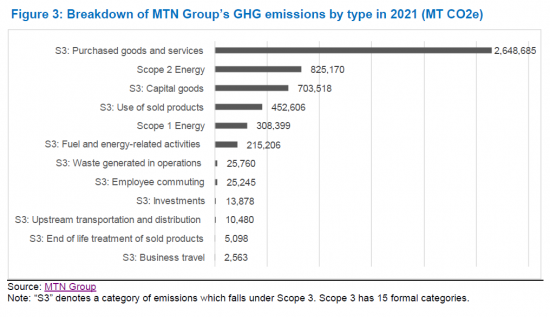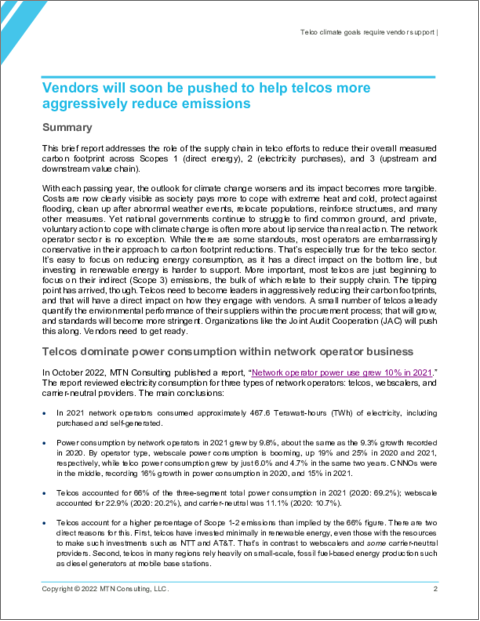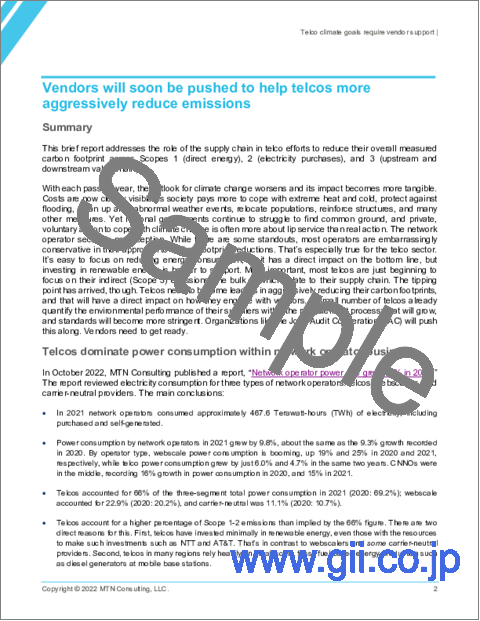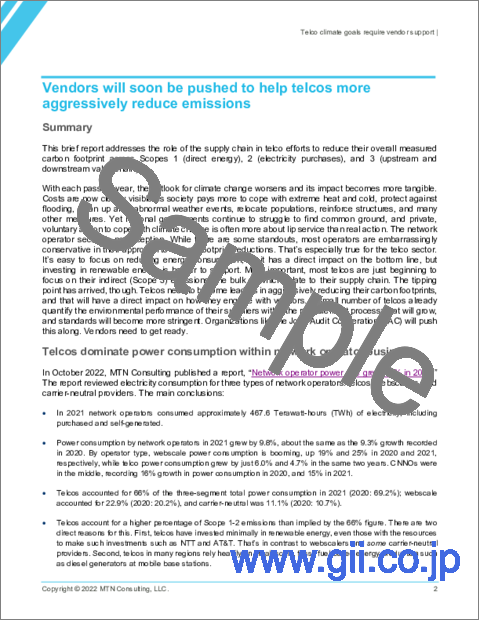|
|
市場調査レポート
商品コード
1168240
通信企業の気候目標達成に必要なベンダー側の支援:典型的な通信事業者のカーボンフットプリントの大半をサプライチェーンが占め、その対応だけが、「未来のネットゼロ」へのより積極的な道を支える唯一の方法であるTelco Climate Goals Require Vendor Support: Supply Chain Accounts for Over Half of Typical Telco's Carbon Footprint, Tackling This is Only Way to Support a More Aggressive Path Towards a Net Zero Future |
||||||
| 通信企業の気候目標達成に必要なベンダー側の支援:典型的な通信事業者のカーボンフットプリントの大半をサプライチェーンが占め、その対応だけが、「未来のネットゼロ」へのより積極的な道を支える唯一の方法である |
|
出版日: 2022年12月06日
発行: MTN Consulting, LLC
ページ情報: 英文 12 Pages
納期: 即納可能
|
- 全表示
- 概要
- 図表
- 目次
当レポートでは、世界の通信業界のカーボンフットプリント削減の取り組みにおいてサプライチェーンが果たす役割に焦点を当てて、Scope1 (直接エネルギー)・Scope2 (電力購入)・Scope3 (バリューチェーンの上流・下流工程) の3段階から、現在の排出状況と目下の課題、今後の対策と影響などを分析しております。
本文中の図表より

気候変動の見通しは年を追うごとに悪化し、その影響はより具体的になっています。猛暑や寒さへの対応、洪水対策、異常気象の後始末、住民の移転、構造物の補強など、社会が負担するコストは明らかに目に見えるものになっています。しかし、各国政府は共通認識を見出すのに苦労し続け、気候変動に対処するための民間の自主的な行動は、実際の行動というよりリップサービスである場合が多くなっています。ネットワーク事業者の分野も例外ではありません。いくつかの傑出した事業者はいますが、ほとんどの事業者は、二酸化炭素排出量削減へのアプローチにおいて保守的です。特に通信事業者の場合はそうです。エネルギー消費量の削減は収益に直接影響するため、注目するのは簡単ですが、再生可能エネルギーへの投資は支持されにくくなっています。さらに重要なことは、ほとんどの通信事業者が間接排出 (Scope3) に焦点を当て始めたばかりで、その大部分はサプライチェーンに関連するものであるということです。しかし、転換期は到来しています。通信事業者は、積極的に二酸化炭素排出量を削減するリーダーとなる必要があり、それはベンダーとの関わり方に直接的な影響を与えるでしょう。すでに少数の通信事業者が調達プロセスにおいてサプライヤーの環境パフォーマンスを定量化していますが、今後その数は増え、基準もより厳しくなっていくでしょう。共同監査協力会 (JAC) のような組織がこれを推し進めると思われます。ベンダー側も準備をする必要があります。
分析範囲
分析対象企業
|
|
目次
- 概要
- 通信事業者が、ネットワーク事業者ビジネスの中で電力消費量の大半を占める
- scope3排出量:概要
- scope3の事例:SwisscomとMTN Group
- 各種の通信企業の総排出量の50~80%を、サプライチェーンが占める
- 通信事業者の現在の気候目標と調達との関係
- 調達への影響
List of Figures and Tables
- Figure 1: Overview of GHG Protocol scopes and emissions across the value chain
- Figure 2: Breakdown of Swisscom's GHG emissions by type in 2021 (MT CO2e)
- Figure 3: Breakdown of MTN Group's GHG emissions by type in 2021 (MT CO2e)
- Figure 4: Purchased goods and services plus capital goods - total contribution to carbon footprint
- Table 1: Climate goals and procurement practices for select telcos
This brief report addresses the role of the supply chain in telco efforts to reduce their overall measured carbon footprint across Scopes 1 (direct energy), 2 (electricity purchases), and 3 (upstream and downstream value chain).
VISUALS

With each passing year, the outlook for climate change worsens and its impact becomes more tangible. Costs are now clearly visible as society pays more to cope with extreme heat and cold, protect against flooding, clean up after abnormal weather events, relocate populations, reinforce structures, and many other measures. Yet national governments continue to struggle to find common ground, and private, voluntary action to cope with climate change is often more about lip service than real action. The network operator sector is no exception. While there are some standouts, most operators are embarrassingly conservative in their approach to carbon footprint reductions. That's especially true for the telco sector. It's easy to focus on reducing energy consumption, as it has a direct impact on the bottom line, but investing in renewable energy is harder to support. More important, most telcos are just beginning to focus on their indirect (Scope 3) emissions, the bulk of which relate to their supply chain. The tipping point has arrived, though. Telcos need to become leaders in aggressively reducing their carbon footprints, and that will have a direct impact on how they engage with vendors. A small number of telcos already quantify the environmental performance of their suppliers within the procurement process; that will grow, and standards will become more stringent. Organizations like the Joint Audit Cooperation (JAC) will push this along. Vendors need to get ready.
COVERAGE
Companies mentioned:
|
|
Table of Contents
- Summary
- Telcos dominate power consumption within network operator business
- Scope 3 emissions overview
- Scope 3 examples: Swisscom and MTN Group
- Supply chain accounts for 50-80% of total emissions for many telcos
- Telcos' current climate goals and the relationship to procurement
- Implications for procurement




